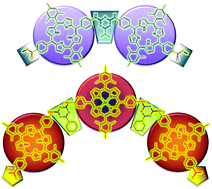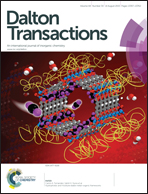A triazine di(carboxy)porphyrin dyad versus a triazine di(carboxy)porphyrin triad for sensitizers in DSSCs†
Abstract
Two porphyrin-chromophores, i.e. triad PorZn-(PorCOOH)2-(piper)2 (GZ-T1) and dyad (PorZn)2-NMe2 (GZ-D1), have been synthesized and their photophysical and electrochemical properties have been investigated. The optical properties together with the appropriate electronic energy levels, i.e. the highest occupied molecular orbital (HOMO) and the lowest unoccupied molecular orbital (LUMO) energy levels, revealed that both porphyrin assemblies can function as sensitizers for dye sensitized solar cells (DSSCs). The GZ-T1 and GZ-D1-based DSSCs have been prepared and studied using 20 mM CDCA as coadsorbent and were found to exhibit an overall power conversion efficiency (PCE) of 5.88% and 4.56%, respectively (under an illumination intensity of 100 mW cm−2 with TiO2 films of 12 μm). The higher PCE of the GZ-T1-sensitized DSSC, as revealed from the current–voltage characteristic under illumination and the incident photon to current conversion efficiency (IPCE) spectra of the two DSSCs, is mainly attributed to its enhanced short circuit current (Jsc), although both the open circuit voltage (Voc) and the fill factor are improved too. The electrochemical impedance spectra (EIS) demonstrated a shorter electron transport time, longer electron lifetime and higher charge recombination resistance for the DSSC sensitized with the dye GZ-T1 as well as a larger dye loading onto the TiO2 surface.


 Please wait while we load your content...
Please wait while we load your content...